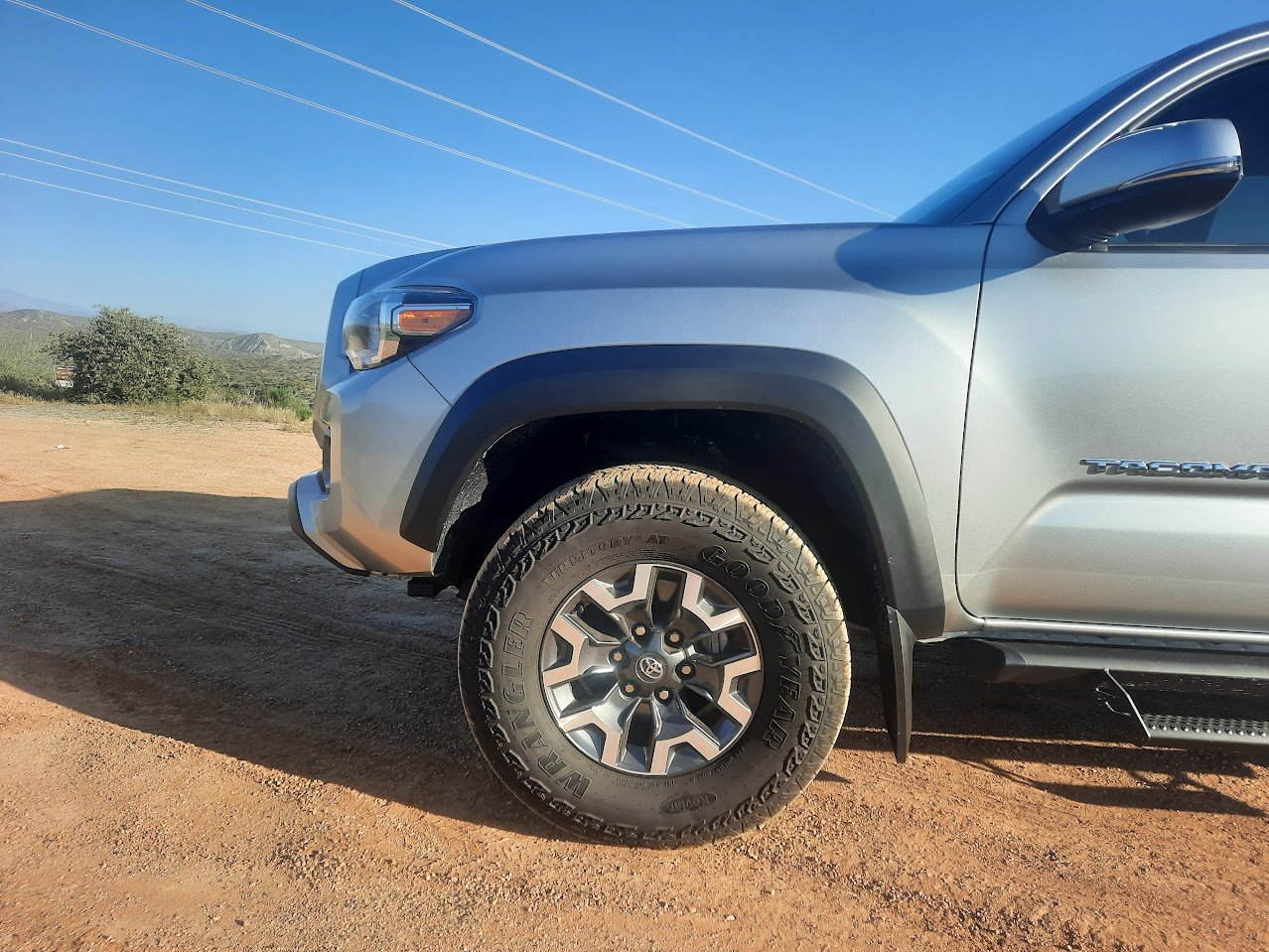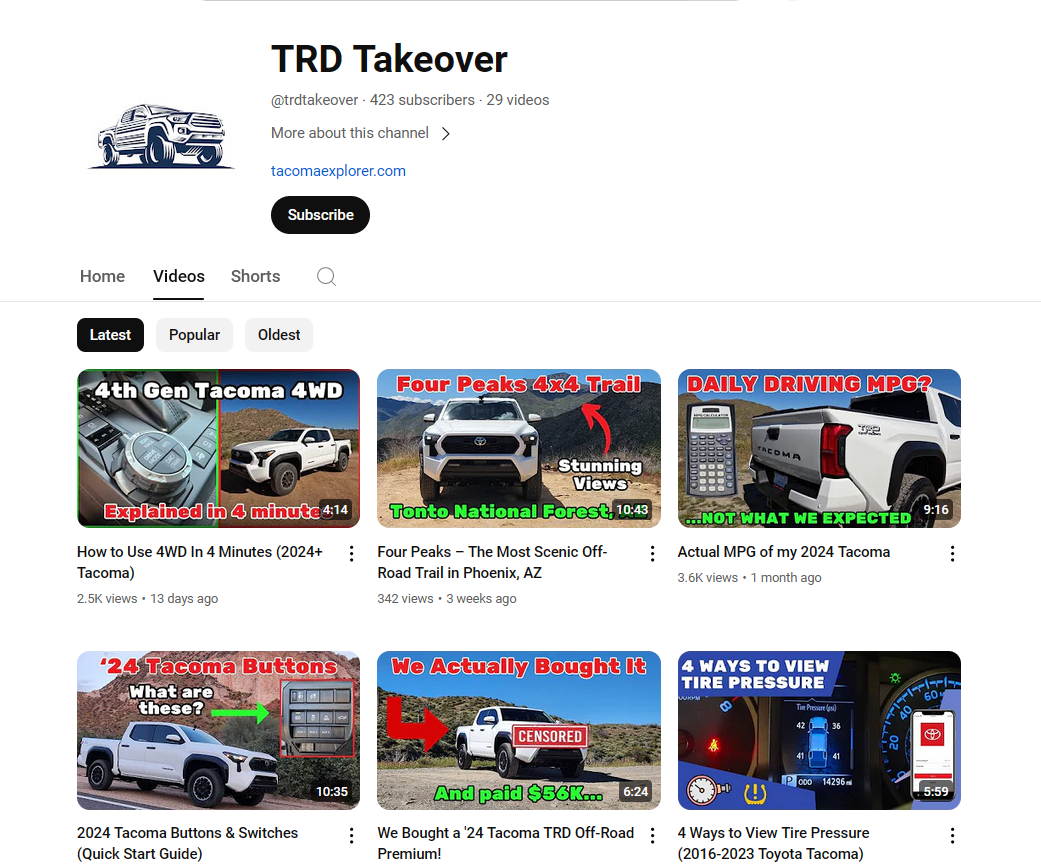Toyota Tacoma Wheel & Tire Maintenance (Expert Insights)
Your tires are the only part of your Tacoma that actually touches the road, so it's important to consider these crucial maintenance items.

Key Points:
- Proper tire and wheel care provided numerous safety, performance, and longevity benefits.
- Improper tire pressure causes increased wear, poor fuel economy, poor ride quality, and more.
- Most Tacomas are equipped with a tire pressure monitoring system (TPMS).
- Routine tire inspection and cleaning is essential.
- Don't forget to maintain your spare tire.
- Tire rotation, tire balancing, and wheel alignment should be performed regularly.
Do you know the risks of neglecting your Toyota Tacoma’s tire maintenance? As someone with substantial experience in the tire industry, I’ve seen the fallout first-hand.
Imagine the stress of an unexpected flat, the cost of early tire replacements due to uneven wear, or the danger of a blowout at high speeds. These are real issues that Tacoma owners face when ignoring proper wheel and tire care.
But there’s a clear solution.
With proper wheel and tire upkeep, you can enhance your Tacoma’s performance and longevity and safeguard your safety on the road.
In this guide, I’ll share my experience to help you navigate the essentials of tire maintenance, from regular pressure checks to seasonal adjustments, ensuring your Taco’s tires stay in top condition.
Understanding Tire Basics
Tires are complex and built from various materials, including natural and synthetic rubber, steel, textiles, and fillers like silica and carbon black. Proper maintenance of this elaborate construction directly affects your Tacoma’s performance.
On the outside, the tread provides crucial traction for safe braking and handling, especially in adverse weather conditions. The sidewalls support the vehicle’s weight and contribute to ride comfort and efficiency.
The unseen steel comprises beads to anchor the tire to the rim and belts for tread support and durability. There are many more components involved; check out this site for a comprehensive look at tire anatomy.
Tire Pressure and Inflation
Maintaining the correct tire pressure is vital for vehicle safety and efficiency. Underinflated tires can lead to increased tire wear and reduced fuel economy, while overinflation can make your ride harsh and affect traction.
For Toyota Tacomas, the correct tire pressures vary across generations, and you can find this vital information at TirePressure.com or on the stick inside the driver’s side door jamb.
Checking and adjusting tire pressure is straightforward but crucial. As Allstate recommends, regular pressure checks can prevent many common tire issues.
Toyota Tire Pressure Monitoring
In recent Tacomas, TPMS and the multi-information display present a critical tire maintenance feature.
Through the multi-informational display, TPMS alerts you to deviations from the optimal tire pressure, allowing for timely adjustments. This system has significantly improved tire safety and maintenance efficiency.
Learn how to view the tire pressure on your Tacoma.
Tire Inspection and Cleaning
From my experience, I advise using a quarter instead of a penny to check your tire’s tread wear, as a quarter provides a more useful measure of tread depth.
When you insert a quarter into your tire’s tread with Washington’s head facing down, if you can see the top of his head, your tread is less than 4/32 inches, and it’s time to consider replacing your tires.
This depth is a more proactive benchmark for safety, especially in wet conditions, compared to the 2/32 inches indicated by the penny test. And 2/32″ is the legal limit in most states, so at that point, the tires are not legal for use on public roads and highways.
Checking the tread depth in each tire groove is crucial to identifying irregular wear, which can indicate alignment issues, improper inflation, or suspension problems. Regularly monitoring your tires helps ensure optimal vehicle performance and safety on the road.
I also advise checking for any signs of cuts, bulges, or foreign objects lodged in the tire tread. These can be early indicators of more significant issues.
Additionally, keeping tires clean is not just about aesthetics; it can prevent damage to the tread and sidewall. For practical tire maintenance tips, see Bridgestone Americas’ guide and Firestone Complete Auto Care’s cleaning advice.
Spare Tire Maintenance
Spare tire maintenance is crucial for your Tacoma, especially because it has a full-size spare.
In addition to regular checks of its condition, age, and pressure, incorporating a full-size spare tire into a five-tire rotation pattern can significantly extend the overall life of your tires. This pattern involves moving the spare into the vehicle’s rotation sequence, ensuring even wear across all five tires.
For guidelines on managing your spare tire, Nationwide’s guide on spare tire maintenance is invaluable.
Off-Road Adventures and Tire Care
Off-roading requires special attention to your tires. Airing down tires is a common practice I recommend for better traction on uneven terrain, as it increases the tire’s footprint. However, be aware that this can also heighten the risk of tire damage and affect handling on regular roads.
Always re-inflate your tires to the recommended pressure before hitting paved roads again. Carrying a portable air compressor can be a lifesaver for these situations. Post-off-road inspections are crucial to identify damage from the lower pressures or rough terrain.
Tire Rotation and Balancing
Tire rotation and balancing are essential to even tire wear and vehicle stability.
We recommend tire rotation for the Tacoma approximately every 5,000 miles. This practice ensures that tires wear evenly, which extends their life and maintains performance.
Balancing the tires at the same intervals is also recommended, as it prevents uneven wear and vibration, contributing to a smoother ride and longer tire lifespan.
Adhering to these service intervals is crucial for maintaining your Tacoma’s performance and safety, mainly if used in varying driving conditions such as city, highway, or off-road.
Wheel Alignment and Suspension
Proper wheel alignment is critical for optimal handling and tire longevity. We recommend checking wheel alignment every 15,000 to 20,000 miles. This interval ensures that any issues caused by normal wear or impacts (like rocks on the trail or potholes in the road) are addressed promptly.
Misalignment can lead to uneven tire wear, poor handling, and decreased fuel efficiency. Suspension components also play a crucial role in maintaining alignment; thus, they should be inspected regularly for wear or damage, primarily if your Taco is frequently used for off-roading or in harsh driving conditions.
Winter Tire Maintenance
In colder regions, winter tires are not just a luxury but a necessity for safety. These tires offer better traction in snow and ice.
It is crucial to know when to switch to winter tires and how to store them properly when not in use. This practice ensures safety and extends the life of both your regular and winter tires.
Tire Upgrades and Options
Choosing the right tire for your Tacoma is essential. Consider how you use your Tacoma when determining load rating, tread pattern, and noise levels based on your driving needs.
For example, all-terrain tires balance off-road capability and on-road manners, while mud-terrain tires are better suited for frequent off-road use unless you love their noise on highways!
Conclusion
Based on my experience in the tire industry, I can’t overstate the importance of regular wheel and tire maintenance for Toyota Tacoma owners.
Implementing these strategies will ensure your safety and enhance your driving experience. Always seek professional advice for your tire care needs when in doubt.

